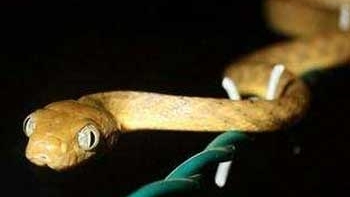NWRC Research Areas: Invasive Species on Islands (Brown Treesnakes Research)

Our scientists are developing strategies and methods to manage the brown treesnake and protect endangered species and other wildlife, improve public health, and protect power stations and other sensitive locations from intrusion.
Native bird populations were absent from all but the northern third of Guam by 1970. Today, of the 12 native species of forest birds on Guam, only the Mariana Crow, the island swiftlet and the Micronesian starling survive in the wild, with the crow population on the verge of extinction. Other birds have been taken into captive breeding programs. Bat populations on Guam have declined along with the bird populations. In fact, most of the island's native terrestrial vertebrates have been extirpated.
A major cause of the decline of these species is an introduced predator—the brown treesnake. The treesnake, native to Australia, the Solomon Islands, New Guinea and Indonesia, was most likely accidentally introduced to Guam through post World War II cargo shipments.
Since 1995, NWRC has received funding from the U.S. Department of Defense (DoD) Legacy Resource Management Program to research methods to manage brown treesnakes. The DoD is the steward of about 25 million acres of land in the United States. These lands are varied and often rich in threatened and endangered species, critical habitats, and sensitive ecosystems. The Legacy Program, established in 1990, provides funding for the DoD's efforts to 'enhance stewardship on military lands while supporting the military mission.' The NWRC has also received funding from the U.S. Department of the Interior, Office of Insular Affairs.
Management of the brown treesnake, through the development of integrated strategies, is aimed at preventing its dispersal through cargo; containing incoming snakes at destinations; reclaiming areas on Guam for reintroduction of native wildlife; protecting endangered species and other wildlife, improving public health; and protecting power stations and other sensitive locations from intrusion. To achieve these aims, brown treesnake research efforts at NWRC encompass development of repellents, attractants, toxicants, fumigants, reproductive inhibitors and improved trapping methods.
Brown Treesnake Aerial Bait Broadcasts
The NWRC has developed and is evaluating the aerial broadcast of acetaminophen-treated mice baits to reduce the population of invasive brown treesnakes (BTS) on Guam.
Starting in 2013, two 55-hectare forest plots on Guam will be aerially treated with acetaminophen mouse baits and compared to an untreated 55-hectare reference site over a 16-month period. NWRC scientists will monitor snake and rodent abundance before, during, and after the drops to evaluate the overall effectiveness and environmental impact of the baiting operation.
This effort is a culmination of over 15 years of research by scientists at the NWRC in collaboration with their project partners with the Department of Defense, Department of the Interior, and the Guam Department of Agriculture. The successful aerial delivery of an effective chemical control agent is a critical next step towards developing a method for large area control of brown treesnakes, reaching snakes in remote and inaccessible areas of Guam, and to support possible wildlife restoration efforts on Guam.
Photos
Videos
Contact Us
Invasive Species on Islands (Brown Treesnakes)
Steven Hess, Project Leader
Email: steven.hess@usda.gov
Phone: 808-932-4750
Hawaii Field Station
P.O. Box 10880
Hilo, HI 96721

